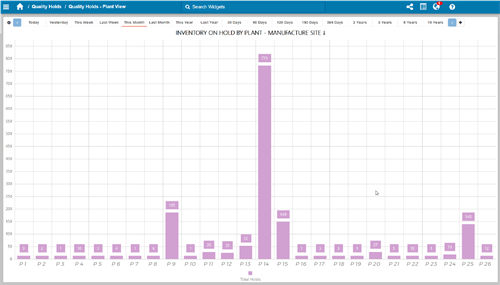You have 35 different warehouses full of inventory. The inventory is constantly changing, moving from one location to another, and getting shipped in and out. The status of the inventory items changes from available to unavailable, and people adjust quantities up and down. Ideally, you would want to see what is going on across all your inventory – but without any real way of looking at it all in a single view, it can be excruciating. You either have separate warehouse management systems at each of the sites, or you own half of the facilities while 3PLs run the other half, and you have no visibility into their system operations.
Solution: Real-Time Inventory
 We developed trigger points in our software, Rebus©, to track supply chain inventory changes. We can follow when items move, get adjusted up or down, and so forth. Having visibility to this real-time data allows businesses to display it on dashboards across the warehouses within the distribution network.
We developed trigger points in our software, Rebus©, to track supply chain inventory changes. We can follow when items move, get adjusted up or down, and so forth. Having visibility to this real-time data allows businesses to display it on dashboards across the warehouses within the distribution network.
The top-down view of enterprise-wide inventory is a valuable capability that sets Rebus apart from any other supply chain management software. Especially when analyzing the way warehouse systems operate, for example, an ERP is at the top while the WMS is at the bottom, all the data feeds up. However, this approach leads to issues, because although the WMS’s are feeding the ERP, they are only tracking inventory items at the lot level or item lot stay, which lacks inventory details at the high level where it is valuable.
With Rebus’ top-down view, you can drill down to piece identification code. For example, if you have a case full of pens, you can track it down to one box and know that that one box is sitting in this case, on this specific pallet, in this exact rack. You now have access to that deep level of detailed information.
How does Real-Time Inventory Visibility Increase a Company’s Efficiency or ROI?
Inventory visibility increases a company’s efficiency or ROI in a couple of ways, mostly dependent on what you are trying to achieve.
Scenario 1 – Real-Time Inventory Reporting
You need to drill down to a specific level of detail to understand what your inventory is and where it is located; however, you have multiple systems. In order to gather the information you need, you are looking at plenty of manual work to determine what the disposition of your inventory is. This could mean having to open five different sessions of an application, investigate each instance, do an extract of the data, and aggregate it all into a spreadsheet. Then finally, you will be able to see what your inventory looks like – but is it in real-time?
This manual approach to reporting is time-consuming and unnecessary. With a consolidated view of real-time data into your inventory, any business can make quick decisions that can save them hundreds of thousands of dollars.
Scenario 2 – Shift Inventory
You can shift inventory from one location to another. For instance, you can see in real-time if you have an abundance of one product that failed to sell, got damaged, or is to expire soon. Which allows you the capability of rather than eventually discarding it; you can make an informed decision on how to proceed. You could have the customer service representatives contact clients directly – offering the excess goods at a discounted rate or sell the products to a secondary market. There are a variety of tangible benefits you would obtain from having the view of real-time data on the products in your warehouse.
A keynote is that this data is in real-time because, yes, it is possible to gather this data in a spreadsheet, for example. However, that spreadsheet takes time, labor, and money to compile. Not to mention that the completed spreadsheet would not hold the current information by the time you look at it. Something may have already happened to the damaged inventory – the warehouse might have already recouped the items; that is just one example of why real-time data is so important and valuable to you.
Inventory Visibility & Quality Assurance
Inventory Visibility is a crucial component of Rebus. Also referred to as Quality Assurance, by having real-time visibility into inventory at any level, you can also view detail into products that are being released or placed on quality hold.

The Inventory Visibility/Quality Assurance dashboards were designed and developed because one of our Global Packaging Food Manufacturing clients was having issues viewing QA holds at the plant level due to data constraints with their systems. In essence, they put a hold on a product, but the interface would fail, and the hold would not be processed at the warehouse. This leads to unnecessary risks, such as – shipping damaged product to a customer, which could be catastrophic. Leading to a product recall that could damage a company’s reputation, ruin their customer relationships, and result in hundreds of thousands of dollars lost.
Rebus provides visibility into real-time QA metrics and data to avoid these unnecessary risks. By giving real-time visibility to all of the inventory based on lot number, location, and status, the client could easily identify at-risk inventory and prevent these issues before they occurred.
By: Stephanie Alvarado
Download our Case Study to Learn How Real-Time Distribution Center Analytics Helped Subaru Increase Productivity and Enhance Labor Reporting


